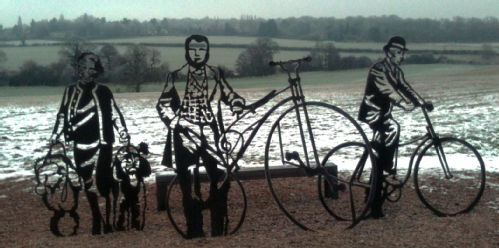New portrait bench
 A new Portrait Bench has been installed midway along the new cycle route between Kenilworth and the University. The bench is part of a new and unique National collection of local portraits, with a total of 230 people across the UK chosen to be represented by their local community. The figures are selected for their personal contribution to the life of their community and honours individuals for their philanthropy, technological achievements, or acts of heroism. The Portrait Bench features three distinctive, life-sized local figures cut from sheet steel and installed by a simple seat, from which passers-by can stop to enjoy the views across open countryside.
A new Portrait Bench has been installed midway along the new cycle route between Kenilworth and the University. The bench is part of a new and unique National collection of local portraits, with a total of 230 people across the UK chosen to be represented by their local community. The figures are selected for their personal contribution to the life of their community and honours individuals for their philanthropy, technological achievements, or acts of heroism. The Portrait Bench features three distinctive, life-sized local figures cut from sheet steel and installed by a simple seat, from which passers-by can stop to enjoy the views across open countryside.
The three portraits celebrate:
Helen Martin
1907-1988
Warwick University’s 'Unknown Benefactor'. In 1963, Helen Martin, of Spring Court, Kenilworth, set up a charitable trust to support the newly created
University. Helen started the trust with a personal £5,000 gift and her generous donations continued even after her death in 1988, when the University of Warwick was well on the way to becoming the world renowned institution it is today.
The Trust's total contribution since its inception is equivalent to £28 million at today's prices. This is believed to be the largest continuous record of private giving to a British university from a single source in the postwar period.
John Kemp Starley
1854-1901
In 1885 John Kemp Starley made history when he produced, in Coventry, the Rover Safety Bicycle a chain-driven bicycle with similar sized wheels. The term safety was due to it being more stable than the previous high wheeler (penny farthing) designs. The Cycling magazine said the Rover had 'set the pattern to the world' and the phrase was used in their advertising for many years. Starley's Rover is referred to as the first recognisable modern bicycle. The design was an immediate success and was exported across the world. In 1889 the company became J. K. Starley & Co. Ltd and in the late 1890s, it had become the Rover Cycle Company Ltd.
Edward Langley Fardon
1839-1926
Edward Langley Fardon grew up in Stoneleigh,where some of the family still resides. He was an accomplished whitesmith and engineer. During the 1860s the early examples of modern bicycles were being produced and E.L. Fardon followed these developments with interest. Towards the end of that decade he produced what is agreed to be a most significant evolution of these designs. “I should be glad if you will kindly allow me to say that I made a bicycle with wire spokes and indiarubber tyres at Kenilworth in 18681869.” E.L. Fardon, Engineer Magazine 1895. He is acknowledged as a pioneer of bicycle design by the Veteran Cycle Club. The workshop and forge he occupied still exists in the centre of Stoneleigh.
Information kindly provided by Sustrans.
